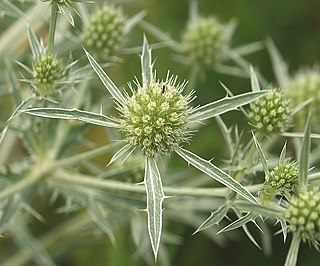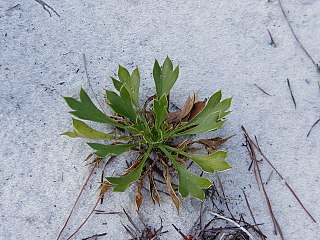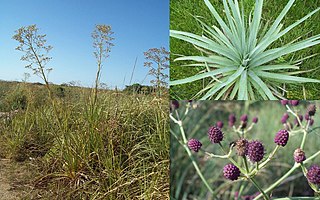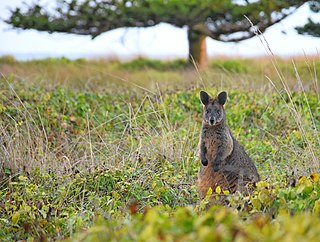
Eryngium is a genus of flowering plants in the family Apiaceae. There are about 250 species. The genus has a cosmopolitan distribution, with the center of diversity in South America. Common names include eryngo and sea holly.

Eryngium maritimum, the sea holly or sea eryngo, or sea eryngium, is a perennial species of flowering plant in the family Apiaceae and native to most European coastlines. It resembles a plume thistle in appearance on account of its burr-shaped flower. Despite its common name, it is not taxonomically related to true holly, but is an umbellifer.

Eryngium alpinum, the alpine sea holly, alpine eryngo or queen of the Alps, is a herbaceous perennial plant in the family Apiaceae.

Eryngium campestre, known as field eryngo, or Watling Street thistle, is a species of Eryngium, which is used medicinally. A member of the family Apiaceae, eryngo is a hairless, thorny perennial plant. The leaves are tough and stiff, whitish-green. The basal leaves are long-stalked, pinnate and spiny. The leaves of this plant are mined by the gall fly, Euleia heraclei.

Eryngium pinnatifidum, commonly known as blue devils, is a species of plant in the family Apiaceae. It is endemic to the south-west of Western Australia. It grows up to 50 cm in height and produces blue or white flowers between August and November in its native range.

Eryngium aristulatum, known by the common names California eryngo and Jepson's button celery, is a species of flowering plant in the family Apiaceae.
Eryngium constancei is a species of flowering plant in the family Apiaceae known by the common name Loch Lomond button celery, or Loch Lomond coyote thistle. It is endemic to California, where it is known from only three occurrences north of the San Francisco Bay Area. One of the populations is at the Loch Lomond Vernal Pool Ecological Reserve at Loch Lomond in Lake County. The plant appears mainly in vernal pools. It is endangered on the state and federal levels.

The Loch Lomond Vernal Pool Ecological Reserve is a nature reserve of 8.22 acres (33,300 m2) in the community of Loch Lomond in Lake County, California. It is one of 119 ecological reserves managed by the California Department of Fish and Game (CDFG). The ecological reserve system was authorized by the state legislature in 1968 for the purpose of conservation and protection of rare plants, animals and habitats.
Eryngium pinnatisectum is an uncommon species of flowering plant in the family Apiaceae, known by the common names Tuolumne eryngo and Tuolumne button celery.

Eryngium foetidum is a tropical perennial herb in the family Apiaceae. Common names include culantro, recao, chadon beni, Mexican coriander, bandhaniya, long coriander, Burmese coriander, sawtooth coriander, and ngò gai. It is native to Mexico, the Caribbean, and Central and South America, but is cultivated worldwide, mostly in the tropics as a perennial, but sometimes in temperate climates as an annual.

Eryngium cuneifolium is a rare species of flowering plant in the carrot family known by the common names wedgeleaf eryngo, wedge-leaved button-snakeroot, and simply snakeroot. It is endemic to the state of Florida in the United States where it is known only from Highlands County. It is one of many rare species that can be found only on the Lake Wales Ridge, an area of high endemism. It was federally listed as an endangered species of the United States in 1987.

Eryngium planum, the blue eryngo or flat sea holly, is a species of flowering plant in the family Apiaceae, native to the area that includes central and southeastern Europe and central Asia. It is an herbaceous perennial thistle growing to 50 cm (20 in) with branched silvery-blue stems, and numerous small blue conical flowerheads surrounded by spiky bracts in summer.

Portrait of the Artist Holding a Thistle is an oil painting on parchment pasted on canvas by German artist Albrecht Dürer. Painted in 1493, it is the earliest of Dürer's painted self-portraits and has been identified as one of the first self-portraits painted by a Northern artist. It was acquired in 1922 by the Louvre in Paris.

Eryngium aquaticum is a species of flowering plant in the family Apiaceae known by the common name rattlesnakemaster, marsh rattlesnake master, corn-snakeroot, bitter snakeroot, and marsh eryngo. This plant is native to eastern North America.

Eryngium pandanifolium, or pandan-like-leaved eryngo, is a species of flowering plant in the genus Eryngium, native to Brazil, Paraguay, Uruguay, and Argentina, and introduced in Australia, New Zealand, and Portugal. It has gained the Royal Horticultural Society's Award of Garden Merit.

The Victorian Volcanic Plain Grasslands are a critically endangered temperate grasslands that occur in the Australian state of Victoria, stretching from Hamilton in the northwest to the city of Melbourne. Part of the Southern Volcanic Plain and bordering the Gippsland Plains Grassy Woodland to the east, the grasslands sit on Cainozoic volcanic deposits. In 2011, the Victorian Government had reserved 15,000 hectares of land to protect the critically endangered community. Only less than 5% of the pre-European concentration of the grasslands remain.

The Iron-grass Natural Temperate Grassland of South Australia is a temperate grassland in the southeast of South Australia that stretches from Orroroo in the north, to Strathalbyn in the south, just straddling the eastern fringes of Adelaide's Mount Lofty Ranges. Listed as Critically Endangered under the EPBC Act, the grasslands predominantly feature Iron-grasses.

The Northern Plains Grassland (NPGL) is an open, shrubby temperate grassland community located in northern Victoria straddling the Murray Darling Depression and Wimmera, extending to the Riverina and South Western Slopes regions in southern New South Wales. Floristically rich, the area features 30 native plant species per 100 m2.

The Southern Tablelands Temperate Grassland, formally Natural Temperate Grassland of the Southern Tablelands, is a temperate grassland community situated in the Southern Tablelands and Monaro region of New South Wales, extending into the Australian Capital Territory and the Victorian border. Listed as Endangered under the Environment Protection and Biodiversity Conservation Act 1999, the grassland is dominated by reasonably tall, dense to open tussock grasses.

















